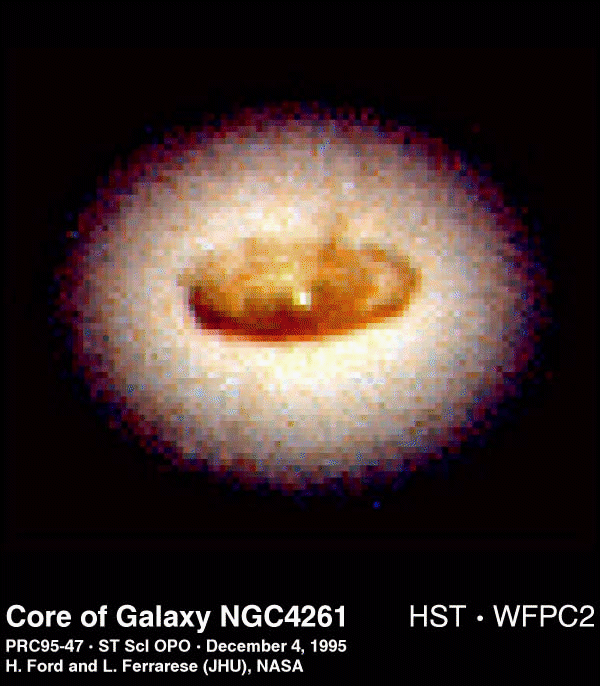 This
Hubble Space Telescope image contains three main features. The outer
white area is the core or centre of the galaxy NGC4261. Inside the
core there is a brown spiral-shaped disk. It weighs one hundred
thousand times as much as our sun. Because it is rotating one can
measure the radii and speed of its constituents, and hence weigh the
object at its centre. This object is about as large as our solar
system, but weighs 1,200,000,000 times as much as our sun. This means
that gravity is about one million times as strong as on the
sun. Almost certainly this object is a black hole.
This
Hubble Space Telescope image contains three main features. The outer
white area is the core or centre of the galaxy NGC4261. Inside the
core there is a brown spiral-shaped disk. It weighs one hundred
thousand times as much as our sun. Because it is rotating one can
measure the radii and speed of its constituents, and hence weigh the
object at its centre. This object is about as large as our solar
system, but weighs 1,200,000,000 times as much as our sun. This means
that gravity is about one million times as strong as on the
sun. Almost certainly this object is a black hole.
1915 Einstein published his celebrated work on
the theory of gravitation, general relativity. A remarkable
feature of Einstein's equations, which describe the effect that
matter has on the curvature of spacetime, is the prediction of black
holes in our universe. Einstein's equations constitute a system of
nonlinear partial differential equations. The available mathematical
results for this system are rather sparse and there is a large number
of open and important mathematical problems in this field.
To read more about my interest in general relativity click on
research.




 Web page of:
Web page of: This
Hubble Space Telescope image contains three main features. The outer
white area is the core or centre of the galaxy NGC4261. Inside the
core there is a brown spiral-shaped disk. It weighs one hundred
thousand times as much as our sun. Because it is rotating one can
measure the radii and speed of its constituents, and hence weigh the
object at its centre. This object is about as large as our solar
system, but weighs 1,200,000,000 times as much as our sun. This means
that gravity is about one million times as strong as on the
sun. Almost certainly this object is a black hole.
This
Hubble Space Telescope image contains three main features. The outer
white area is the core or centre of the galaxy NGC4261. Inside the
core there is a brown spiral-shaped disk. It weighs one hundred
thousand times as much as our sun. Because it is rotating one can
measure the radii and speed of its constituents, and hence weigh the
object at its centre. This object is about as large as our solar
system, but weighs 1,200,000,000 times as much as our sun. This means
that gravity is about one million times as strong as on the
sun. Almost certainly this object is a black hole.